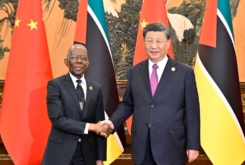The government of Mozambique has set a very ambitious goal of achieving universal electrification by 2030, up from a rate of just 28% at present. This is a laudable goal and it is right that Maputo is seeking to spread the benefits of electricity to as many people as quickly as possible. Yet the scale of the required financing makes it doubtful whether the target can be achieved despite the number of projects currently planned.
The national director of energy, Pascoal Bacelar, said in November: “This ambitious US$5 billion electricity programme will be implemented by the publicly owned electricity company, Electricidade de Moçambique (EDM), and by the government’s Energy Fund…the World Bank, the European Union, Sweden and Norway are expected to jointly provide about US$223m in funding during the first three years of the programme.” However, this is a relatively small sum in relation to the size of the entire project and few details on financing the rest of the programme have been announced.
Other African governments have also pledged to ensure that all homes have access to electricity within a generation. Most notably, Kenya aims to achieve it by 2022 and has already boosted its electrification rate from 23% in 2009 to 75% earlier this year. Connecting the remaining quarter of the population will be more difficult, as these are generally the more difficult to reach residents, living either in remote rural areas or very poor urban districts. However, the progress made over just the past decade gives cause for optimism. Mozambique’s power sector must make similarly rapid progress if the 2030 target is to be taken seriously.
In October, the government published its Integrated Master Plan for Electricity Infrastructure for 2018-2043. The plan requires estimated investment of US$34 billion, including US$18 billion in generation, spread over hydro, gas and coal fired capacity, US$9 billion in transmission and US$7 billion in distribution. It allows for national generating capacity of 17,720 MW but demand of just 8,000 MW, with exports making use of the remainder.
Mphanda Nkuwa
Achieving the 2030 goal will require a step increase in national generating capacity. The biggest contributor to this could be the long awaited Mphanda Nkuwa hydro scheme, for which China’s Exim Bank is expected to be the main backer. The project site lies just 60km downstream from the established heart of the country’s power sector, the Cahora Bassa dam, on the Zambezi River. As well as increasing power supplies to the domestic market, the project is likely to export electricity to other parts of the Southern African Power Pool (SAPP).
The scheme would have generating capacity of 1,350 MW if developed, with construction costs estimated at US$2.3 billion, although it is not yet clear what proportion of this would be supplied by Exim Bank. The Chinese bank has been involved in the project since 2006, underlining its commitment but also emphasizing just how long the venture has been delayed. It appears that the government wants whoever builds the scheme to use the plan approved in 2007, perhaps with some slight modifications.
A tender was launched to provide consultancy services on the project in March, includingdesigning the legal and financial structure, including for the transmission infrastructure.The government wants to secure the services of a company that has experience on similarly large and complicated projects.
A statement from the Ministry of Mineral Resources read: “The company to be selected will also have to provide all necessary assistance to enable the updating of the technical studies identified as critical and for the selection of the strategic partner to join the state owned power utility EDM and the Cahora Bassa Hydroelectric Plant (HCB) in the development of project infrastructure.”
Project developers have been announced several times over the past decade but no work was actually carried out. Most recently, a consortium of EDM and Insitec, both of Mozambique, plus Brazil’s Camargo Corrêa, held a concession but this was cancelled in August 2018 by the government. Maputo now wants EDM and Hidroeléctrica de Cahora Bassa (HCB) to drive project development but it remains to be seen whether they will actually operate it after it is completed, or whether the company selected to construct it will be offered a stake in the operating company as part of its financial package.
Cahora Bassa
With installed generating capacity of 2,075 MW, Cahora Bassa dominates national capacity of 2,638 MW. Built in the 1970s, it is the biggest hydro scheme in Southern Africa and plays a vital role within the SAPP, exporting electricity to South Africa, Botswana and Zambia. A contract to modernise the project was awarded to Sweden’s Sweco and Brazil’s Intertechne Consultores in April. Its five turbines need upgrading in a rehabilitation programme that is scheduled for completion in 2025.
The president of Sweco Sweden, Ann-Louise Lokholm Klasson, commented: “It’s gratifying to be a part of another project with a great effect on the energy supply in Southern Africa, as well as being involved in a project that is an important part of achieving several of the UN’s global goals for sustainable development.”
In May, the project’s operator, HCB, said that it would hold an initial public offering for a 2.5% stake in the company between 17 June and 12 July, fulfilling a pledged by President Filipe Nyusi in 2017 that Mozambicans would be able to buy part of Cahora Bassa. Shares, which will be offered to Mozambican citizens and institutional investors, will be listed on the Bolsa de Valores de Moçambique, becoming the fifth company to list on the stock exchange and raising 2.040 billion meticals (US$31.7 million) in the process. Two further tranches of 2.5% could be offered at a later date but the government of Mozambique will retain a 92.5% stake in the venture.
Kibo coal
Another obvious option for Mozambique is to utilise a small proportion of its thermal coal production to supply coal fired power plants. Thus far, coal mines have been developed in Tete Province in the far north-west of the country for export but utilising even a small proportion of the coal mined domestically could have a big impact on national power supplies.
Coal is generally regarded as the most polluting form of power generation, both with regard to particulate and carbon emissions, but Mozambique is a very low level global polluter and the industrialised world has yet to come up with the financial incentives necessary to encourage poorer countries to focus solely on renewables at the expense of coal.
Maputo has long encouraged private sector investment in coal-fired plants but no projects have yet come to fruition, partly because additional transmission capacity would be needed to transport electricity from Tete Province, if that is where they are to be built, to the main centres of power demand. However, Kibo Energy has completed a feasibility study into its Benga coal-to-power project, in which it holds a 65% stake,with the remaining equity held by Termoelectrica de Mozambique de Benga.
It has also held talks with EDM – and apparently other prospective off-takers – over long term power purchase agreements (PPAs). In the first instance at least, Benga is expected to have generating capacity in the range of 150-300 MW. CEO Louis Coetzee said:“Working in Mozambique has been notably straightforward as evidenced by the timely advancement of Benga.” He added:“The fact that we are already discussing commercial power offtake and being able to progressively integrate the outcomes with the technical work of the DFS [definitive feasibility study], allows us to align the power station design accurately with offtakers’ requirements.”
While Kibo would source coal from third party suppliers, Ncondezi Energy is opting for an integrated mine and power project. In November, it announced that it had signed a memorandum of understanding on a PPA relating to generating capacity of 300 MW. The company is believed to have agreed a 10% reduction in previously agreed power tariffs.
The company’s chairman, Michael Haworth, said in April that progress had been made with its partners, China Machinery Engineering (CMEC) and GE South Africa. This appears to refer to the acquisition of 60% equity in the venture by the two companies. CMEC vice president Fang Yanshui added: “CMEC is looking forward to realising the JDA [joint development agreement] soon and believes that together with GE and Ncondezi there is strong confidence to deliver the high efficiency and advanced Ncondezi integrated power plant and mine.”
Gas options
Mozambique is set to acquire its first large gas-fired plant if the planned 400 MW Temane facility in Inhambane Province in the south of the country proceeds as planned. South African firm Sasol and Empresa Nacional de Hidrocarbonetos (ENH) are to supply feedback to the plant from their established Pande and Temane fields, which already pipe gas to Sasol’s synthetic fuel facilities in South Africa. UK development investment institution Globeleq farmed into the project last June with a 30.6% stake, alongside partner eleQtra. Sasol holds a 49% equity share, while EDM will retain 20.4%.
Power production will be sold to EDM under a 25 PPA. The CEO of Globeleq, Paul Hanrahan, said “The Temane project will provide Mozambique with significant base load power to help drive economic growth.” EDM chairman Mateus Magala added that the project would help his company achieve the goal of providing universal access to affordable electricity by 2030.
While generation projects attract most attention, 100% electrification is equally reliant on investment in transmission and distribution to transport electricity around the country. The government hopes to oversee the construction of a transmission line down the centre of the country that will form the backbone of a national power grid.
The next step is scheduled to be a line between the 400 MW gas plant planned for Inhambane and the main centre of power consumption, Maputo. Greater power sector integration within the SAPP will also be required. For instance, a new transmission line is planned from Matambo in Mozambique to Phombeya in Malawi but funding still needs to be finalised with German development bank KfW and others.(CLBRief)



